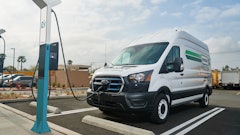
Trucks.com reports that 34 states currently have rules that block trucks and fleets from platooning, a fuel-saving technology. However, a new study reports that legislatures are now starting to allow the industry to start adopting the practice.
Platooning digitally tethers convoys of two or more trucks to travel closely together to reduce drag and increase fuel efficiency, according to Trucks.com.
In a report by Competitive Enterprise Institute, it said that in the last year, 10 states have cleared the way for trucks to travel with as little as 40 feet between them. The report states that trucks must have radio-based technology and automatic emergency braking.
Peloton Technologies expects to have two-truck platooning available by the end of 2018. So far, the company claims that more than 7 percent of fuel has been saved by trucks accelerating and braking at close distances.
Trucks.com reports that most legislatures are voting in favor of the changes that focuses on loosening regulations concerning the distances driver must maintain between vehicles.
Georgia and Tennessee were the first states to pass the platooning legislation last year with Arkansas, North Carolina, South Carolina and Texas quickly following with certain exceptions. According to Trucks.com, Michigan's automated vehicle law included a platooning-friendly exemption, and Alabama, Indiana, Kentucky, Louisiana, Mississippi, Nevada, Oregon, Utah and Wisconsin also enacted rule exemptions this year.
Arizona recently passed a law to allow limited, Trucks.com reports. Ohio will also allow platooning within existing laws.
With more states starting to implement platooning, it expands the market and provides greater potential for fuel savings.
Freight transportation practice leader for the Texas A&M Transportation Research Institute, Allan Rutter, believes that technology experiments can go beyond platooning and that autonomous trucking needs to be considered along with basic platooning.
To read the full original article, please click here.


























